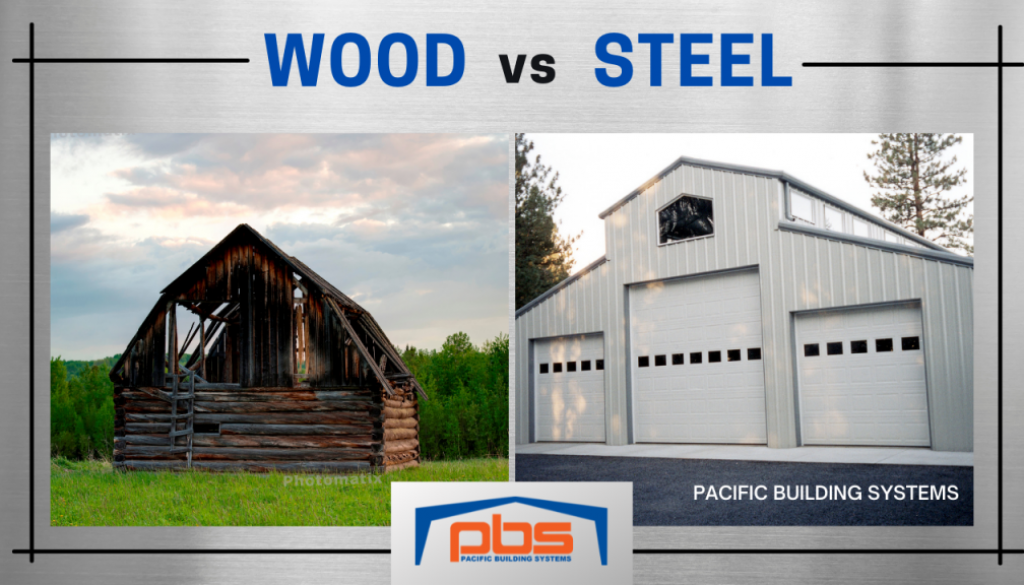Why Steel is a Superior Building Material Compared to Wood
Wood vs Steel: Which Building Material is Better?
Having a tough time deciding between a pre-engineered metal building or a wood-frame building? Steel and wood are two of the most commonly used building materials on the market, and both materials have their advantages. However, when it comes to strength and longevity, steel is superior.
Steel structures and pre-engineered metal buildings (PEMB) present significant advantages over conventional wooden buildings. Here are a few reasons why steel is a superior building material based on research and tests done by the MBMA (Metal Building Manufacturers Association).
✓ Steel is Stronger than Wood.
Why is Superman known as “The Man of Steel”? Why do we describe brave and resilient people with phrases like “made of steel” and not “made of wood”? Because steel is stronger! Except for exotic materials like titanium, steel is THE strongest building material available. It is so much stronger than other building materials, and it’s almost impossible to compare.
Because of its enormous strength, steel can handle more weight on load-bearing walls, so it is more commonly used to construct tall buildings. Steel can also be welded, bolted, or riveted in place, unlike wooden structures held together with nails.
✓ Steel is More Durable and Lasts Longer.
When compared to wood, steel is hands-down the longer-lasting building material. Unlike wood, steel framing will not naturally warp and lose strength over time. Lumber will swell, crack and distort over time as moisture levels change, which affects the stability and durability of the building.
In moist climates like the Pacific Northwest, it’s worth noting that lumber begins to decay when it reaches a moisture content of over 20% (wood’s moisture content is about 30% at the time of harvest). In contrast, steel is impervious to changing moisture levels.
✓ Structures Made of Steel Are More Weather Resistant.
When it comes to extreme weather events, which have unfortunately become more common over the years, steel is the clear choice. Pre-engineered steel buildings are designed to stand up to floods, earthquakes, blizzards, hurricanes, extreme heat, bitter cold, and other weather conditions.
✓ Steel Doesn’t Rot or Attract Pests.
Prefabricated steel buildings are less susceptible to damage and costly repairs resulting from maintenance nightmares that commonly plague property owners, like bore-bees, termite infestation, wood rot, mold, mildew, or other fungi growth.
✓ Steel is More Consistent Than Wood.
By nature, wood is an inconsistent building material. The quality of the lumber used in conventional wood-framed buildings depends on its tree species, the age of the tree, and the region it originates from. Insect infestations, climate, and rainfall patterns can all affect the strength of wood.
As a man-made material, steel is manufactured in precise conditions to achieve properties and a level of quality that will remain consistent throughout the structure’s life. Wood is a material that naturally deteriorates over time, while steel will last for generations.
✓ Wood is Combustible. Steel is Not.
Noncombustible materials like steel are unlikely to burn when faced with heat. This is a huge advantage in regions facing hazards, like forest fires and dry conditions.
✓ Steel is a Reusable Material.
Due to its inconsistent properties mentioned above, builders often reject up to 20% of a lumber order due to flaws. Rejected lumber and wooden frames are rarely recycled and usually end up in landfills. Steel, however, can be recycled multiple times without losing strength, a huge advantage for builders adapting to green building policies and codes.
✓ Compared to Wood, Steel is a Better Investment.
Upon first glance, a conventional wood building may appear cheaper upfront than steel buildings. However, when compared side-by-side with a pole barn or timber-framed building, a Pre-Engineered Metal Building (PEMB) is actually the more affordable option. The costs will eventually add up, as you will need to conduct more maintenance and replace warped wood or rotting timber.
We estimate the overall cost of building with a Pre-Engineered Metal Building (PEMB) kit is actually up to 20% less than wood buildings when calculating how much is saved on cost, labor, and maintenance.
In addition, when you purchase a Pre-Engineered Metal Building (PEMB) kit from Pacific Building Systems, you are getting a higher-than-average quality of steel components.
This is a wiser investment for government buildings, schools, retail stores, industrial buildings, manufacturing facilities, garage/maintenance shops, office buildings, agricultural shelters, and more because the amount of time and money you will spend in repairs and efforts to keep a wood building standing will far exceed the cost of building a pre-engineered steel structure.
With all the value that steel offers, it’s easy to see why it is a preferred building material for many industrial, commercial, agriculture, and storage projects. Only you can decide what building material works best for your building, but when you invest in a prefabricated steel building kit like the ones manufactured at Pacific Building Systems, you will enjoy a high-quality building customized to your preferences with minimal upkeep for generations to come.
Whether you are in the initial planning stages of your commercial/industrial building or have already finalized your plans, we will work to make your building a reality. For over 50 years, we’ve provided high-quality, affordable steel building components for a variety of industries, including the industrial, commercial, agricultural, aviation, government, and community sectors.
Contact our team today to discover why our commercial steel buildings are advantageous for your business.
Ready to get started?
We have what it takes to make your next project a reality.
Contact a project consultant today.

